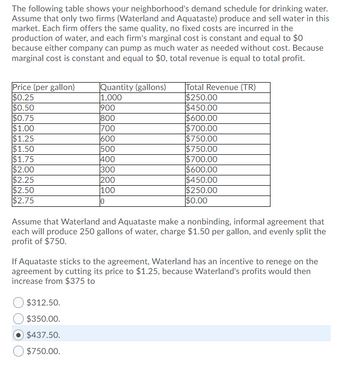
ENGR.ECONOMIC ANALYSIS
14th Edition
ISBN: 9780190931919
Author: NEWNAN
Publisher: Oxford University Press
expand_more
expand_more
format_list_bulleted
Question
Note:-
- Do not provide handwritten solution. Maintain accuracy and quality in your answer. Take care of plagiarism.
- Answer completely.
- You will get up vote for sure.

Transcribed Image Text:The following table shows your neighborhood's demand schedule for drinking water.
Assume that only two firms (Waterland and Aquataste) produce and sell water in this
market. Each firm offers the same quality, no fixed costs are incurred in the
production of water, and each firm's marginal cost is constant and equal to $0
because either company can pump as much water as needed without cost. Because
marginal cost is constant and equal to $0, total revenue is equal to total profit.
Price (per gallon)
$0.25
$0.50
$0.75
$1.00
$1.25
$1.50
$1.75
$2.00
$2.25
$2.50
$2.75
Quantity (gallons)
1,000
900
800
700
600
500
400
300
200
100
0
Total Revenue (TR)
$250.00
$450.00
$600.00
$700.00
$750.00
$750.00
$700.00
$600.00
$450.00
$250.00
$0.00
Assume that Waterland and Aquataste make a nonbinding, informal agreement that
each will produce 250 gallons of water, charge $1.50 per gallon, and evenly split the
profit of $750.
$312.50.
$350.00.
$437.50.
$750.00.
If Aquataste sticks to the agreement, Waterland has an incentive to renege on the
agreement by cutting its price to $1.25, because Waterland's profits would then
increase from $375 to
Expert Solution
This question has been solved!
Explore an expertly crafted, step-by-step solution for a thorough understanding of key concepts.
This is a popular solution
Trending nowThis is a popular solution!
Step by stepSolved in 3 steps

Knowledge Booster
Learn more about
Need a deep-dive on the concept behind this application? Look no further. Learn more about this topic, economics and related others by exploring similar questions and additional content below.Similar questions
- Note:- Do not provide handwritten solution. Maintain accuracy and quality in your answer. Take care of plagiarism. Answer completely. You will get up vote for sure.arrow_forwardNote:- Do not provide handwritten solution. Maintain accuracy and quality in your answer. Take care of plagiarism. Answer completely. You will get up vote for sure.arrow_forwardNote:- Do not provide handwritten solution. Maintain accuracy and quality in your answer. Take care of plagiarism.Answer completely.You will get up vote for sure.arrow_forward
- Accordingtothetextbook,whichofthefollowingstatementsis(are)correct? (x) When a taxpayer attempts to legally reduce her tax liability, she is engaging in “tax evasion” and when an individual fraudulently avoids paying taxing, she is engaging in “tax avoidance”. (y) One tax system is considered more efficient than another if it raises the same amount of tax revenue at a lower cost to taxpayers. (z) Part of the administrative burden of a tax is associated with the headache of filling out tax forms imposed on taxpayers who comply with the tax. (x), (y) and (z) (x) and (y) only (x) and (z) only (y) and (z) only (x) onlyarrow_forwardwhat are the numbers that go in the cost table A through L Note:- Do not provide handwritten solution. Maintain accuracy and quality in your answer. Take care of plagiarism. Answer completely. You will get up vote for sure.arrow_forwardAn investor is considering the following two investments.•Investment 1 has an expected rate of return (profit) of 8% and costs $40 per share.•Investment 2 has an expected rate of return (profit) of 5% and costs $30 per share.The investor has $100 to invest to maximize her total expected rate of return, and shemust buy whole shares (not partial/factional shares) of the investments.(a) Formulate the investor’s integer programming problem.(b) Solve the investor’s problem using branch and bound and explain youranswer. How much of each investment does the investor purchase?arrow_forward
- Note:- Do not provide handwritten solution. Maintain accuracy and quality in your answer. Take care of plagiarism. Answer completely. You will get up vote for sure.arrow_forward(J) Everyone living in Isolation, Alaska works at one of two fish canneries for their entire life. Over a career at Placid Cannery a worker is paid $1 million and the risk of death by canning machine is 1%. At Megadeath Cannery a worker is paid $1.2 million and the risk of death is 5%. What is the value of a statistical life in Isolation? Show your work.arrow_forwardRevenue and Costs ($) TC P61 Given TFC = $40.00 Q1 = 30.00 Q2 = 40.00 TR P6 P5 Q3 = 50.00 Q4 = 80.00 Q5 = 86.00 P4. P1 = $40.00 P2 = $50.00 P3 = $60.0o P4 = $150.00 P5 = $200.00 P6 = $210.00 P61 = $320.00 P3 P2 P1 Q1 Q2 Q4 Q5 Q3 Exhibit TR-TC Output (Q) Refer to Exhibit TR-TC for a typical competitive firm. At an output level of Q5, the firm's losses is about O $100.00 O $90.00 O $110.00 O $120.00arrow_forward
arrow_back_ios
arrow_forward_ios
Recommended textbooks for you

 Principles of Economics (12th Edition)EconomicsISBN:9780134078779Author:Karl E. Case, Ray C. Fair, Sharon E. OsterPublisher:PEARSON
Principles of Economics (12th Edition)EconomicsISBN:9780134078779Author:Karl E. Case, Ray C. Fair, Sharon E. OsterPublisher:PEARSON Engineering Economy (17th Edition)EconomicsISBN:9780134870069Author:William G. Sullivan, Elin M. Wicks, C. Patrick KoellingPublisher:PEARSON
Engineering Economy (17th Edition)EconomicsISBN:9780134870069Author:William G. Sullivan, Elin M. Wicks, C. Patrick KoellingPublisher:PEARSON Principles of Economics (MindTap Course List)EconomicsISBN:9781305585126Author:N. Gregory MankiwPublisher:Cengage Learning
Principles of Economics (MindTap Course List)EconomicsISBN:9781305585126Author:N. Gregory MankiwPublisher:Cengage Learning Managerial Economics: A Problem Solving ApproachEconomicsISBN:9781337106665Author:Luke M. Froeb, Brian T. McCann, Michael R. Ward, Mike ShorPublisher:Cengage Learning
Managerial Economics: A Problem Solving ApproachEconomicsISBN:9781337106665Author:Luke M. Froeb, Brian T. McCann, Michael R. Ward, Mike ShorPublisher:Cengage Learning Managerial Economics & Business Strategy (Mcgraw-...EconomicsISBN:9781259290619Author:Michael Baye, Jeff PrincePublisher:McGraw-Hill Education
Managerial Economics & Business Strategy (Mcgraw-...EconomicsISBN:9781259290619Author:Michael Baye, Jeff PrincePublisher:McGraw-Hill Education


Principles of Economics (12th Edition)
Economics
ISBN:9780134078779
Author:Karl E. Case, Ray C. Fair, Sharon E. Oster
Publisher:PEARSON

Engineering Economy (17th Edition)
Economics
ISBN:9780134870069
Author:William G. Sullivan, Elin M. Wicks, C. Patrick Koelling
Publisher:PEARSON

Principles of Economics (MindTap Course List)
Economics
ISBN:9781305585126
Author:N. Gregory Mankiw
Publisher:Cengage Learning

Managerial Economics: A Problem Solving Approach
Economics
ISBN:9781337106665
Author:Luke M. Froeb, Brian T. McCann, Michael R. Ward, Mike Shor
Publisher:Cengage Learning

Managerial Economics & Business Strategy (Mcgraw-...
Economics
ISBN:9781259290619
Author:Michael Baye, Jeff Prince
Publisher:McGraw-Hill Education